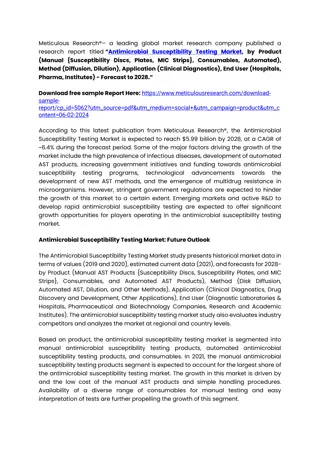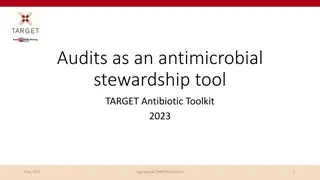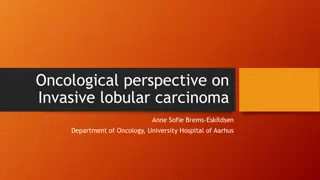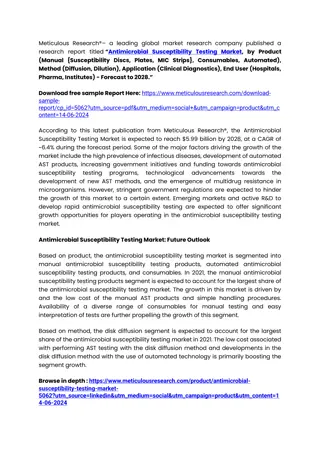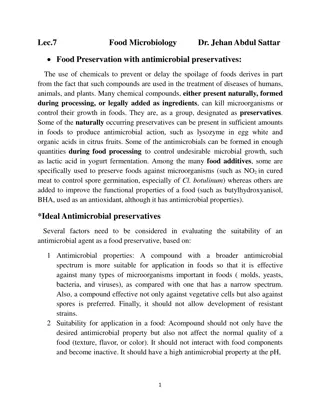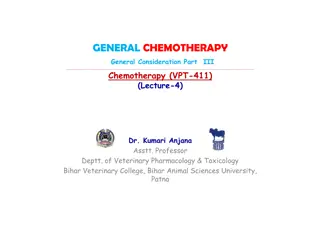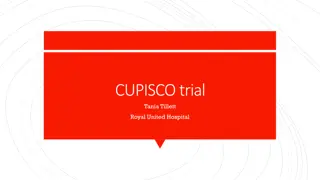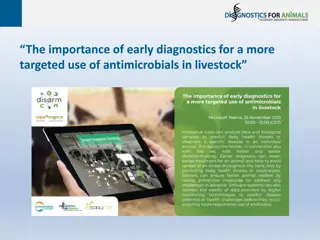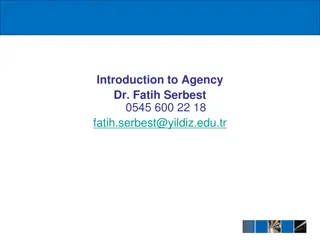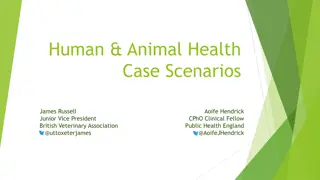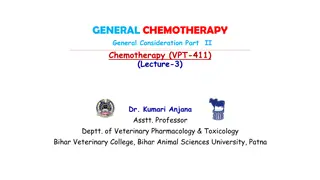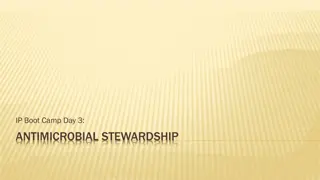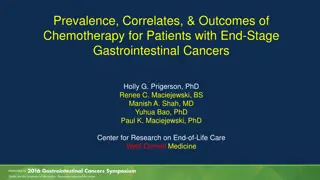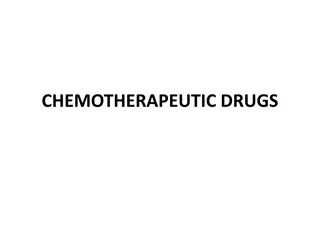Understanding Antimicrobial Chemotherapy Agents
Chemotherapeutic agents, including antibiotics, semi-synthetic antibiotics, and synthetic drugs, are used to treat infectious diseases. These agents should possess ideal characteristics such as selectiveness, broad antimicrobial spectrum, no side effects, and suitable bioavailability to be effective. Different classes of drugs target specific microbial groups, ranging from antibacterial to antiviral drugs.
Download Presentation

Please find below an Image/Link to download the presentation.
The content on the website is provided AS IS for your information and personal use only. It may not be sold, licensed, or shared on other websites without obtaining consent from the author. Download presentation by click this link. If you encounter any issues during the download, it is possible that the publisher has removed the file from their server.
E N D
Presentation Transcript
Unit VI Unit VI Antimicrobial chemotherapy Antimicrobial chemotherapy The term chemotherapeutic agent applies to chemical substances used for the treatment of infectious diseases or the prevention of disease. Treatment of diseases using chemotherapeutic agent is called chemotherapy. There are three types of chemotherapeutic agents:- Chemotherapeutic agents: 1. Antibiotics: natural products 2. Semi-synthetic antibiotics: modified natural products 3. Synthetic drugs
UNIT VI Antimicrobial chemotherapy Antimicrobial chemotherapy Mr. S. N. Mendhe Department of Microbiology, Shri Shivaji Science and Arts College, Chikhli
i) Antibiotic:- It is a chemical substance produced by one organism that kills or inhibits the growth of another pathogenic organism. Antibiotics are called natural chemotherapeutic agents. Penicillin, Streptomycin, Chloramphenicol etc ii) Semi-synthetic antibiotics: These are modified natural products. e.g. Rifampicin iii) Synthetic chemotherapeutic agents:- These are the chemical drugs which are synthesized in the laboratory, e,g. Sulfonamides, AZT, etc.
Ideal Characteristics of a chemotherapeutic agent Selective selectively toxic i.e. it should be toxic for the microorganism not for host. Antimicrobial spectrum:- The drug should be able to destroy or inhibit many kinds of pathogenic microorganisms. No side effects:- The drug should not produce undesirable side effects. No killing effect on normal flora: - The drug should not destroy the normal flora of the body. toxicity:- The drug should be
No inactivation :- When the drug is given orally, it should not be inactivated by stomach acids. Solubility in body fluids :- A drug must have solubility in body fluids. Sufficient concentration of the drug in target tissues :- The drug must be able to reach sufficiently in high concentration in the tissues or the blood of the patient. Low break down rate of drug :- Break down rate of drug must be low so that it will remain in the tissues long enough to exert its effects. Availability :- Easily availability at affordable cost or prices.
Effectiveness Of Drugs Drugs vary effectiveness. Many are narrow-spectrum drugs i.e. that are effective only against a limited number of microorganisms. Others are broad spectrum & attack many different kinds of pathogens. Drugs may also be classified on the basis of general microbial group they act against- Antibacterial (Bacitracin), Antifungal (Ketoconazole, Fluconazole) Antimycotic ( Amphotericin B ) Antiprotozoan (Metronidazole), Antihelminthic (Benzimidazoles) & Antiviral (Acyclovir). considerably in their range of
Antibacterial agents Rifampicin Rifampicin is a bactericidal antibiotic drug of the rifamycin group. It is a semisynthetic compound derived from Amycolatopsis rifamycinica. MODE OF ACTION: Rifampicin inhibits bacterial RNA synthesis by inhibiting bacterial RNA Polymerase. CLINICAL USE: Rifampicin is used to treat Mycobacterium infections, including Tuberculosis and Hansen s disease. It is also used to treat infection by Listeria species, Neisseria gonorrhoeae, Haemophilus Neisseria meningitidis. Rifampicin is used in the treatment of methicillin- resistant Staphylococcus osteomyelitis. Rifampicin has some effectiveness against Vaccinia virus. influenzae and aureus (MRSA) including
Chloramphenicol is a bacteriostatic broad-spectrum antibiotic, effective against a wide variety of Gram-positive and Gram-negative bacteria. Chloramphenicol was originally Streptomyces venezuelae. MODE OF ACTION stops bacterial growth by Chloramphenicol prevents peptide bond formation and thus protein chain elongation by inhibiting the peptidyl transferase activity of the bacterial ribosome. CLINICAL USE chloramphenicol used in the treatment of typhoid. Chloramphenicol may be used as a second-line agent in the treatment of cholera. It is the first choice treatment for staphylococcal brain abscesses. Chloramphenicol is active against the three main bacterial causes of meningitis: Neisseria meningitidis, Streptococcus pneumoniae and Haemophilus influenzae. Chloramphenicol used to control Chytridiomycosis (a fungal disease in amphibians), responsible for the extinction of one-third of the 120 frog species lost since 1980. derived from the bacterium inhibiting protein synthesis.
Streptomycin Streptomycin is a bactericidal antibiotic, derived from the Streptomyces griseus. Streptomycin is given intramuscularly but not given orally. Mode of action: Streptomycin is a protein synthesis inhibitor. It binds to the small 16S rRNA of the 30S subunit of the bacterial ribosome, interfering with the binding of formyl-methionyl-tRNA to the 30S subunit. This leads to codon misreading, eventual inhibition of protein synthesis and ultimately death of microbial cells. Clinical use: It was the first antibiotic remedy for tuberculosis. Used to treat Infective endocarditis caused by enterococcus . Earlier Streptomycin was used to treat Plague (Yersinia pestis) as the first-line treatment. Used in veterinary medicine, as first-line antibiotic for use against gram negative bacteria in large animals (horses, cattle, sheep, etc.). Streptomycin also is used as a pesticide to control bacterial and fungal diseases of certain fruit, vegetables, seed, and ornamental crops. It also controls algae in ornamental ponds and aquaria.
Ciprofloxacin Ciprofloxacin is a broad spectrum antibiotic in a group of drugs called fluoroquinolones, active against both Gram-positive and Gram-negative bacteria. Ciprofloxacin is used alone or in combination with other antibacterial drugs treatment of infections. Mode of action: It functions by inhibiting DNA gyrase (topoisomerase) enzymes which removes super coils formed during DNA unwinding process during DNA replication. Clinical use: Ciprofloxacin is used to treat a number of infections, including Urinary tract infections Respiratory Tract Infections Gastrointestinal, and abdominal infections Acute cystitis in females Acute Sinusitis Skin infections Bone and joint infections Infectious diarrhea Typhoid Fever (enteric fever) caused by Salmonella typhi Cervical and urethral gonorrhea (due to Neisseria gonorrhoeae)
Antiviral agents Azidothymidine- Azidothymidine (AZT) also called Zidovudine (ZDV) is a type of antiviral drug used for the treatment of HIV/AIDS. AZT is structural anlog of thymidine. Mechanism of action. AZT works by inhibiting DNA synthesis. AZT inhibits the action of HIV's reverse transcriptase enzyme that makes a DNA copy from its RNA. Due to structural analogy with nucleosides they are incorporated in place of nucleotide bases in the growing strands & thereby block the addition of any more nucleotides to the DNA strand and stops DNA synthesis. Thus AZT inhibits HIV replication with little effect on human cells. Clinical Use : Recently AZT has been approved for the tratment of AIDS infection.
Amantadine- Amantadine is a drug that has been approved for use both as an antiviral and an antiparkinsonian drug. It is the organic compound 1-adamantylamine. Mechanism of action The mechanism of activity involves interference with a viral protein, M2 (an ion channel), which is required for the viral particle to become "uncoated" once taken inside a cell. Clinical use Amantadine is used for therapy of Parkinson's disease (disorder of the central nervous system). Amantadine is frequently used to treat the chronic fatigue often experienced by patients inflammatory disease in which the fatty myelin sheaths around the axons of the brain and spinal cord are damaged). Amantadine used to treat hyperactivity disorder) neurobehavioral disorder. Children with ADHD find it more difficult to focus and to complete their schoolwork. with multiple sclerosis (an ADHD a (Attention mental deficit- and is disorder
Antifungal agents Antifungal agents Griseofulvin Griseofulvin is an antifungal drug produced by culture of some strains of the mold Penicillium griseofulvum. Mode of action: Griseofulvin indirectly inhibits the synthesis hyphal cell wall of fungi by inhibiting synthesis of nucleic acid & mitosis. The drug interferes with microtubular activity, which is required for mitosis during the cell division process. Clinical use Griseofulvin is used orally only for dermatophytosis. Griseofulvin is reserved for treatment involving nail, hair or large body surface. It is used both in animals and in humans, to treat fungal infections of the skin (commonly known as ringworm) and nails.
Amphotericin B It is antifungal drug produced by Streptomyces nodosus. It is fungicidal, broad spectrum drug. Mode of action Amphotericin B binds with ergosterol, a component of fungal cell membranes, and forms pores in the fungal membrane (transmembrane channel) that leads to monovalent ion (K+, Na+, H+and Cl ) leakage, which causes fungal cell death. Clinical uses: Despite its toxicity, it is widely used for the treatment of systematic fungal infections like Cryptococcosis, Histoplasmosis, Candidiasis etc. The potential side effect of drug is kidney damage. Blastomycosis,
Antimicrobial susceptibility testing Antimicrobial susceptibility testing Introduction to Clinical and Laboratory Standards Institute (CLSI) Clinical and Laboratory Standards Institute (CLSI) is a global, volunteer driven, membership supported, nonprofit, standards-developing organization. It is located in USA. Its contact address is clinical and Laboratory Standards Institute, 950 West Valley Road, Suite 2500, Wayne, PA 19087 USA. It is dedicated to developing guidelines for health care community. Formerly this institute was called as National committee on clinical (NCCLS). On 1stJanuary 2005, NCCLS officially changed its name to Clinical and Laboratory Standards Institute (CLSI). standards and laboratory standards
CLSI works to promote the excellence in health care for current and future generations. CLSI is concerned with improving quality in the medical testing and health care field. Clinical and Laboratory Standards Institute's (CLSI) core business is the development of globally applicable consensus documents for health care testing. Vision of CLSI: to be the leader in clinical and laboratory standards to improve quality of medical care. Mission of CLSI To develop best practices in clinical and laboratory testing and promote their use through out the world, using a consensus process that balances the viewpoints of industry, government and health care professions.
CLSI has set up different committees to develop a consensus process in different branches of health care and medical testing. 1) Consensus Committee on Microbiology. 2) Consensus Committee on evaluation protocols. 3) Consensus Committee on clinical chemistry and toxicology. 4) Consensus Committee on haematology. 5) Consensus Committee on molecular methods.
CLSI has developed standardized methods for in vitro susceptibility testing of antifungal agents in 1982. In 1993, CLSI published a document (M2-A5 document) on performance antimicrobial disc susceptibility test. In 1997, CLSI has published a standardized reference method for broth dilution antifungal susceptibility testing of yeast. Standardized methods published by CLSI made inter laboratory data comparison possible. standard for
Minimum Inhibitory Concentration (MIC) Minimum Inhibitory Concentration (MIC) Definition : Minimum Inhibitory Concentration (MIC) is the lowest concentration of an antimicrobial agent that inhibits the visible growth of a microorganism after overnight incubation. A lower MIC is an indication of a better antimicrobial agent. A MIC is the most basic laboratory measurement of the activity of an antimicrobial agent against an organism. Clinically, the Minimum Inhibitory Concentration is used to determine the amount of antibiotics that patient will be given and also determines the type of antibiotic to be used.
Minimal Lethal Concentration (MLC) Minimal Lethal Concentration (MLC) Another measure concentration (MLC) concentration of antimicrobial agent required to kill 99.9% of the microorganisms within a specified period. is the minimal is lethal lowest - it the
Antimicrobial Susceptibility Testing Antimicrobial Susceptibility Testing Methods Methods Different microbial different degrees of susceptibility to different antimicrobial drugs. Testing can indicate to which agents a pathogen is most susceptible & give an estimate of the proper therapeutic dose. The basic measure of this susceptibility is the minimal inhibitory concentrations (MIC). species & strains have
DISC DIFFUSION METHOD The most widely used testing method is the disk diffusion susceptibility test which is also known as Kirby-Bauer method. Principle :-Antimicrobial susceptibility testing with discs is a simple & rapid method & provides a reproducible means of testing bacterial sensitivity to various antibiotic & chemotherapeutic agents . Procedure:- Preparation of plates:- Sterile Mueller Hinton Ager (pH 7.4 + 0.2) is poured into Petri-plates to a depth of approx. 4 mm. After the medium has solidified, dry the plates for 30 min in an incubator (35-370C) to remove excess moisture from surface. 2) Inoculation:- i) Dip a sterile cotton swab into the diluted culture inoculum and rotate it while pressing against the upper inside wall of the tube, to remove excess inoculum. ii) Steak the agar surface of the plate in three directions turning by 600 between each streaking. iii) Replace the lid of the petri dish & keep it at room temperature for 5 to 10 min to dry the inoculums. Confluent growth is desirable for accurate results.
3) Application of discs:- Remove the disc with the help of a flamed forceps and carefully place it on the surface of the medium. Finally press it lightly with the forcep to make complete contact with the surface of the medium. Allow the plates to stand at room temperature of 30 min (Prediffusion time). 4) Incubation:- Incubate the plates at 35 370C for 16 to 18 hours. During incubation the chemotherapeutic agent diffuse from the disk into the agar. 5) Reading of zones:- Measure the diameter of the zone of inhibition at the end of the incubation period. If the drug is effective a zone of inhibition formed immediately around the disk. The diameter of zone of inhibition can be measured. The zone diameter is compared to standard chart for that drug & concentration, & report the result whether the organisms is sensitive, intermediate or resistant to the chemotherapeutic agent.
Disc Diffusion Method Disc Diffusion Method
Antimicrobial Susceptibility Testing Methods for Determination of Minimum Inhibitory Concentration (MIC) In these tests, the minimum amount of antibiotic that inhibits the visible growth of an isolate or minimum inhibitory concentration (MIC) is determined. Bacterial isolates are exposed to various dilutions of antibiotics. The highest dilution of antibiotic that has inhibited the growth of bacteria is considered as MIC. These tests can be performed on broth or agar. The methods are - 1) Broth dilution methods a) Macrobroth dilution b) Microbroth dilution 2) Agar dilution methods
Macrobroth dilution susceptibility tests The broth macrodilution test is performed in round bottom sterile glass tubes (12 75 mm). Two fold dilutions of the drug are prepared in broth tubes (Muller Hinton broth) from 0 to maximum concentration. The bacterial inoculum is standardized according to McFarland standard. The suspension should have a final inoculum of 5x105cfu/ml. Each tube is inoculated with 1ml. of standardized inoculums of test organism including control tube that does not contain drug. Tubes are incubated at 370C overnight. The lowest concentration completely inhibits visual growth of bacteria (no turbidity) is recorded as MIC. of antibiotic that
Microbroth Microbroth dilution susceptibility tests dilution susceptibility tests The microbroth dilution test is performed by using sterile, disposable, multiwell microdilution plates (96 U shaped wells). The serial two fold antibiotics/drugs are prepared in Muller Hinton broth in the wells of microdilution plate. The bacterial inoculum is standardized according to McFarland standard. The bacterial inoculum is then inoculated into the wells and incubated at 370C overnight. The lowest concentration completely inhibits visual growth of bacteria (no turbidity) is recorded as MIC. dilutions of different of antibiotic that
Agar dilution method Agar dilution method A serial two-fold dilution of the antibiotic is prepared in Mueller-Hinton agar. The bacterial inoculum according to McFarland standard. Using calibrated loops a volume of 0.001-0.002 ml is inoculated on the surface of agar and incubated at 370C overnight. The lowest concentration of antibiotic that inhibits visible growth on surface of agar is taken as MIC. is standardized


